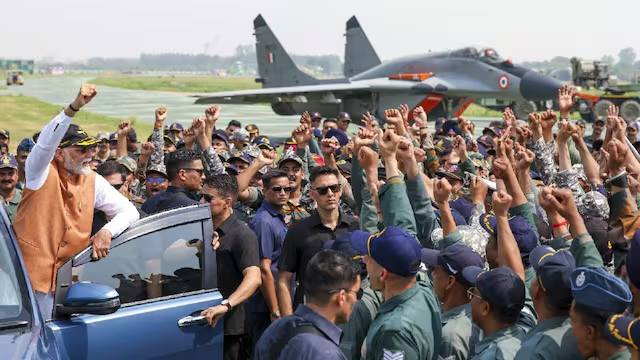Prime Minister Modi has brought India a long way from those dark days of helplessness, wrong decisions, abdications, hesitations, and lack of self-faith
India unleashed Operation Sindoor with Prime Minister Narendra Modi leading from the front. India’s immediate response to it had the clear Modi imprint. On the one hand, India immediately alerted the global community to the heinousness of the act, pinpointing its epicentre in Pakistan; and, on the other hand, India launched a multipronged rescue operation and assessment. Union Home Minister Amit Shah was immediately deputed to Jammu & Kashmir by Prime Minister Modi, who himself kept a second-to-second tab on the situation, being on a crucial foreign visit. PM Modi cut short his visit and, on landing, set the other mechanisms in motion. These eventually led to the successful execution of Operation Sindoor.
It is not Modi’s way to react immediately or on the spur of the moment. His actions are calculated to inflict maximum damage on India baiters and at the same time to consolidate and enhance national strength and capacity. Those who have contemplated his “Panch Pran” will discern this core approach. Each of the five action-pledges is meant to consolidate and crystallise national will and national self-confidence.
One of the clearly defined dimensions of India’s national security doctrine, as articulated and exercised by PM Modi in the last one decade, is to assess and weigh in the options, prepare to the hilt, make a short-term and long-term assessment and then strike or retaliate. Each retaliation is meant to be a greater and more powerful deterrence. This is one of the cardinal pillars of India’s national security doctrine under PM Modi, it is a principal dimension of the “Modi Doctrine.” The adversary is kept guessing, multiple voices aren’t heard speaking and interpreting the situation, no information is leaked, and no one can predict the time and manner in which India will choose to respond.
Operation Sindoor heralds India’s steady emergence, under PM Modi’s leadership, as a responsible power with an unprecedented level of self-control and focus. Throughout the operation, India’s stand and approach was focused on responding assertively to the terror network. Unlike the satanic state of Pakistan, which shelled civilian areas in India, targeting temples, hospitals, mosques, schools and colleges, India remained steadfast on only destroying terror hubs and Pakistani military installations that aimed at Indian civilians.
India’s precision strike and the massive destruction it wreaked on the terror infrastructure in Pakistan has sent ripples through that failing state. In three hours, India’s precise and calibrated strikes had destroyed 11 Pakistani airbases, struck ammunition dumps and hit hard air bases which housed F-16 and JF-17 fighter jets, decimating 20 per cent of the Pakistan Air Force infrastructure. The terrorists and their benefactors had not anticipated the scale of devastation. They miscalculated the capacity of the Modi Doctrine and of the national will rallying around it.
The rallying by the global community on the side of India created a huge pool of support for India’s right to exercise the option of retaliation. This was possible because of the indefatigable diplomatic visits that PM Modi has undertaken over the last one decade. These outreaches, all of them bearing the imprints of his creative and imaginatively strategic diplomatic skills, have yielded results. Pakistan had been diplomatically isolated post the Pahalgam terror attack.
All attempts to re-hyphenate India and Pakistan since May 10 have failed and will continue to fall flat. That the Pakistan army DGMO called his Indian counterpart and waved the white flag after Islamabad had taken a series of disastrous hits is evident to anyone who studies the sequence of events. It required no mediation; it required no persuasion or convincing. India’s strikes had pushed the Pakistani military establishment to the brink. One of the decisive manifestations of the Modi Doctrine is thus the complete and irreversible de-hyphenation of India and Pakistan. Any narrative which claims otherwise or attempts to resurrect a past situation is bound to fail.
India refused to be cowed down by suggestions or pressures of global powers to initiate talks at a “neutral” venue. Pressures to roll back the decision to keep the Indus Water Treaty in abeyance met with a staunch and resolute disregard. The only driving interest was India’s national security.
Pakistan’s dependence on the Indus waters is more than 80 per cent for its farmland, equaling 16 million hectares, and 93 per cent of total water usage that sustains 237 million people. A disruption of the Indus flow will lead to huge agricultural losses, food shortages, and blackouts, affecting an array of industries. On the other hand, this water will be well utilised to benefit a number of states and UTs in India, which include Ladakh, J&K, Punjab and Haryana.
For over six decades, no leader had the gumption to display such an attitude. The usual policy followed by the Congress dispensations, especially the Manmohan Singh-Sonia Gandhi one, was to allow India to be hit, then pushed to the negotiating table and forced to compromise without any palpable benefit, while ensuring it was business as usual on accords such as the Indus Water Treaty. When PM Modi asserted that henceforth any future act of terror will be seen as an act of war, it was a decisive inclusion in the rubric of the Modi Doctrine. PM Modi was also the only global leader to call the bluff on the dubious distinction between “good terrorism” and “bad terrorism.”
When PM Modi reiterated that water and blood cannot flow together, he became the first Prime Minister to draw that line. It was a full stop; the line was demarcated. India’s stance would no longer be defined by false sentimentalism and a hollow sense of statesmanship. It was one more indication that India had clearly and permanently opted out of the satellite-state status. With Narendra Modi assuming power in 2014, that approach was already becoming clear with each passing year.
In 1965, India was compelled to proceed to a third location, Tashkent, to sign a “peace treaty” with Pakistan, giving up on all her strategic gains. India’s then-Prime Minister did not survive the ordeal. In 1971, while a peak was reached, the Indira regime fell for Pakistan’s ruse in Simla, squandering away the unprecedented vantage position and advantages that had been won. In October 1962, in his address to the nation, in the wake of the Chinese attack, Prime Minister Nehru clearly showed that he had given up. He said, “I wish you well and, whatever may befall us in the future, want you to hold your head high…” He had abdicated to the aggressor.
PM Modi has brought us a long way from those dark days of helplessness, of wrong decisions, of abdications, of hesitations and of a lack of self-faith. He is infusing a civilisational sense of self-confidence. His address to the nation, in the wake of Operation Sindoor, powerfully expressed that new reality.
(The views expressed are the author's own and do not necessarily reflect the position of the organisation)



